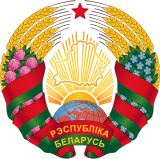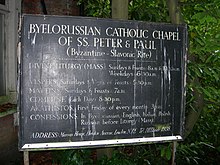Belarusians in the United Kingdom
 From Wikipedia - Reading time: 9 min
From Wikipedia - Reading time: 9 min
| Total population | |
|---|---|
| Belarusian-born residents 4,406 (2011 UK census) | |
| Languages | |
| British English • Belarusian • Russian | |
| Religion | |
| Eastern Orthodox Church • Roman Catholicism • Greek Catholicism • Judaism | |
| Related ethnic groups | |
| Baltic people, Polish British, Ukrainian diaspora in the United Kingdom, Russians in the United Kingdom, Belarusian Americans |
| Part of a series on |
| British people |
|---|
| United Kingdom |
| Eastern European |
| Northern European |
| Southern European |
| Western European |
| Central Asian |
| East Asian |
| South Asian |
| Southeast Asian |
| West Asian |
| African and Afro-Caribbean |
| Northern American |
| South American |
| Oceanian |
| Part of a series on |
| Belarusians |
|---|
 |
| Culture |
| By regions |
| Closely related peoples |
| Religion |
| Languages and dialects |
| Topics |
Belarusians in the United Kingdom (Belarusian: Беларусы ў Вялікабрытаніі, romanized: Biełarusy w Vialikabrytanii) are Belarusians living in the United Kingdom and British people of Belarusian background or descent. The 2001 UK census recorded 1,154 Belarus-born people living in the UK.[1] The 2011 census recorded 4,031 Belarus-born people resident in England, 102 in Wales,[2] 211 in Scotland[3] and 62 in Northern Ireland.[4] Nowadays, organised community life exists only in London.
Terminology
[edit]Belarusians or Byelorussians have been researched, and written of academically and journalistically, as a distinct ethnic group within the United Kingdom.[5]
History
[edit]
According to researcher Natallia Hardzijenka, the first significant wave of immigration from Belarus to the UK took place in late 19th and the beginning of 20th century.[citation needed]
Another significant wave came after the Second World War. A large number of those were former Belarusian military personnel of the Polish Anders Army. According to estimates, ten to twelve thousands of Belarusians arrived to the UK in the aftermath of the war. A significant number of them later emigrated to other countries (mainly the US, Canada and Australia). Many of the Belarusians who resettled in Britain during this period were registered or counted as Polish people, despite being ethnic East Slavs. This was due to Belarus not yet being considered an independent nation, and therefore the Belarusian ethnic group was similarly disregarded in statistics.[5]
During the 1960s, Ceslaus Sipovich and Alexander Nadson became notable religious figures for Belarusians in London,[6] and were involved with the Belarusian Memorial Chapel.[7]
Community
[edit]
There have been Belarusian community centres in London, Manchester and Bradford as well as several religious centres.
The Belarusian St. Cyril of Turau Boys' School was active in London in the 1960s and 1970s.[8] This school was reopened in 2015 and has classes for children and adults on Saturdays and Sundays.
The Anglo-Belarusian Society was founded in 1954 to promote contacts between the Belarusian diaspora and the British establishment.[8]
There are several other Belarusian organisations in the UK, including the Association of Belarusians in Great Britain, the Anglo-Belarusian Society and the Professional Union of Belarusians in Britain.
The Belarusian Catholic Mission was established in 1946. In addition to its religious work, it has contributed to various secular initiatives of the Belarusian community in the UK, including the Francis Skaryna Belarusian Library and Museum. The Mission built the church of St Cyril of Turau and All the Patron Saints of the Belarusian People – the first Belarusian Catholic church outside Belarus and the first wooden church in London since the Great Fire of 1666.
External links
[edit]- Belarusians in Britain blog
- Anglo-Belarusian Society
- Association of Belarusians in Great Britain
- Francis Skaryna Belarusian Library and Museum
- Journal of Belarusian Studies Archived 18 November 2012 at the Wayback Machine
- Professional Union of Belarusians in Britain (PUBB)
British people of Belarusian descent
[edit]See also
[edit]- Belarusian Americans
- Belarusian Canadians
- Russians in the United Kingdom
- Ukrainians in the United Kingdom
References
[edit]- ^ "Country-of-birth database". Organisation for Economic Co-operation and Development. Archived from the original on 17 June 2009. Retrieved 8 April 2010.
- ^ "2011 Census: Country of birth (expanded), regions in England and Wales". Office for National Statistics. 26 March 2013. Retrieved 29 December 2019.
- ^ "Country of birth (detailed)" (PDF). National Records of Scotland. Retrieved 29 December 2019.
- ^ "Country of Birth – Full Detail: QS206NI". Northern Ireland Statistics and Research Agency. Retrieved 29 December 2019.
- ^ a b John Allan Tannahill (1958). "The Nationalities of the Immigrants". European volunteer workers in Britain. Manchester University Press. p. 14.
Byelorussia was not recognised as a separate nation by the Western Powers at the end of the war, and those Byelorussians who came in due course to Britain mainly arrived as Poles ... So far as Byelorussians in Britain are concerned, their name (particularly if the translation of White Russians is used) is unfortunately apt to be confused with the so-called 'White Russian' émigrés of 1917, and lack of general knowledge about their background weakens their cause.
- ^ Christopher Lawrence Zugger (2001). "Bibliography". The Forgotten: Catholics of the Soviet Empire from Lenin through Stalin. Syracuse University Press. p. 532.
- ^ "About Belarusian Church, London". Belarusian Memorial Chapel. 20 November 2016.
The white birches were originally planted in the 60-s by bishop Ceslaus Sipovich (1914–1981) and Fr Alexander Nadson (1926–2015)— to remind them of their beloved motherland.
- ^ a b Наталля Гардзіенка: “Беларуская дыяспара ў Вялікабрытаніі – з’ява ўнікальная на Захадзе” Archived 19 May 2010 at the Wayback Machine
 KSF
KSF